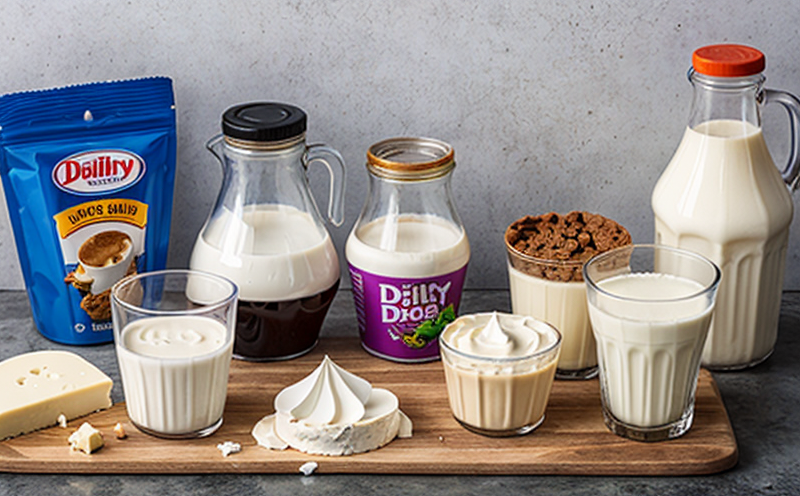ISO 63581 Nutrient Retention Analysis in Dairy Beverages
The ISO 63581 standard provides a robust framework for assessing the nutrient retention in dairy beverages. This service is particularly important for ensuring that processed dairy products maintain their nutritional integrity during manufacturing processes such as pasteurization, homogenization, and packaging.
Understanding nutrient retention in dairy beverages is crucial for food manufacturers and processors who seek to comply with regulatory standards while delivering high-quality products. By analyzing the nutrient content before and after processing, companies can demonstrate that their production methods are effective at preserving essential nutrients like calcium, vitamins (A, D, B12), protein, and fat.
The process involves several key steps:
- Sample preparation: Milk samples are collected from various stages of production. These include raw milk, pasteurized milk, homogenized milk, and packaged dairy beverages.
- Analytical methods: Advanced spectroscopic techniques such as near-infrared (NIR) spectroscopy or atomic absorption spectrophotometry (AAS) are used to determine the initial nutrient levels in raw milk. Post-processing analyses measure changes in these nutrients after processing.
- Data analysis: The results from both pre- and post-processing samples are compared using statistical methods prescribed by ISO 63581 to calculate retention percentages accurately.
This service is essential for maintaining product quality, ensuring compliance with international standards, and providing transparency to consumers about the nutritional value of their products. It also supports innovation in dairy processing technologies by identifying optimal conditions that minimize nutrient loss.
For instance, homogenization pressure can significantly affect fat particle size distribution which impacts both sensory attributes and nutrient stability. Understanding how different parameters interact during production processes allows manufacturers to optimize procedures for better retention rates without compromising other product qualities like taste or texture.
The results of this analysis are typically presented in a comprehensive report detailing the specific nutrients evaluated, their concentrations at each stage of processing, and any observed changes due to processing conditions. This information helps quality managers make informed decisions regarding process improvements aimed at enhancing nutrient retention.
Compliance with ISO 63581 ensures that dairy beverages meet stringent nutritional requirements set by regulatory bodies around the world. It also builds consumer trust through clear labeling practices and supports sustainable business practices by promoting efficient use of resources during manufacturing processes.
Why It Matters
The importance of nutrient retention analysis cannot be overstated in the dairy industry. Consumers expect their milk products to provide consistent nutritional value regardless of the stage at which they are consumed—from fresh milk straight from the farm to fully processed beverages like chocolate milk or flavored yogurts.
- Consumer Trust: Accurate nutrient retention data builds confidence among consumers who rely on dairy products for essential vitamins and minerals. Misleading labels about nutrient content can damage brand reputation and lead to regulatory action.
- Regulatory Compliance: Many countries have laws requiring specific nutrient levels in dairy products. Non-compliance could result in fines or product recalls, impacting business continuity and profitability.
- Innovation: By identifying factors that influence nutrient stability during processing, manufacturers can innovate new formulations that maintain high nutritional standards while offering unique flavors or textures.
Beyond mere compliance, this service contributes to the broader goal of producing safe, wholesome food products. Ensuring consistent nutrient retention helps protect public health by preventing deficiencies caused by insufficient intakes of vital nutrients like calcium and vitamin D.
Moreover, this analysis supports sustainable practices within the dairy sector by optimizing resource usage during production processes. Efficient use of raw materials translates into lower operational costs for producers while reducing waste generation throughout supply chains.
Scope and Methodology
The scope of ISO 63581 Nutrient Retention Analysis in Dairy Beverages encompasses the evaluation of various nutrients present in dairy beverages over different stages of production. Key elements include:
- Calcium content: Ensuring adequate calcium levels is critical for bone health and overall nutrition.
- Vitamin D content: Vitamin D plays a vital role in calcium absorption, promoting healthy bones and immune function.
- B12 content: Necessary for red blood cell formation and neurological function.
- Protein content: Essential for muscle repair and growth.
The methodology follows strict protocols outlined in ISO 63581 to ensure accuracy and consistency across multiple samples. Each sample undergoes rigorous testing using advanced analytical techniques such as NIR spectroscopy, which provides rapid results with minimal sample preparation required.
Post-processing evaluations involve comparing nutrient concentrations between raw milk and final dairy beverages. This comparison helps identify any significant losses or gains during processing stages like pasteurization and homogenization. Any deviations from expected values are documented meticulously in the final report along with recommendations for process adjustments where necessary.
The analytical approach ensures that all relevant stakeholders have access to reliable data supporting claims made on product labels. This transparency fosters trust between manufacturers, retailers, regulators, and ultimately consumers.
Competitive Advantage and Market Impact
- Innovation Leadership: Companies leveraging ISO 63581 nutrient retention analysis stay ahead of competitors by continuously refining their manufacturing processes to preserve nutritional integrity.
- Consumer Confidence: Brands demonstrating commitment to maintaining high standards of nutrition through consistent testing earn loyalty from health-conscious consumers willing to pay premium prices for quality products.
- Regulatory Compliance: Early adoption of this standard allows firms to anticipate future changes in regulatory requirements, ensuring ongoing compliance even as laws evolve.
In competitive markets where differentiation comes down to subtle differences between offerings, accurate nutrient retention analysis can be a decisive factor. It enables companies to differentiate themselves by highlighting unique selling points such as superior preservation of key nutrients or reduced calorie content achieved through innovative formulations.
Moreover, compliance with international standards like ISO 63581 enhances export opportunities for domestic dairy products seeking entry into global markets where stringent quality controls are enforced. This certification adds value to exports, opening doors to new customer bases and expanding market reach.





